Regulation and Impact from Enforcement of the EU’s Carbon Border Adjustment Mechanism (CBAM) to Prepare for the Implementation of Thailand Industry in the Future
Main Article Content
Abstract
Carbon Border Adjustment Mechanism: CBAM is one the of important regulations under the European Green Deal plan, which the EU has declared. When the draft legislation for the CBAM has been approved by the European Parliament, the first phrase called the transitional period will run from 1 October 2023 until 31 December 2025.
During the transitional period, the CBAM will apply to six groups of imported products, namely: 1) iron and steel, 2) aluminum, 3) cement, 4) fertilizer, 5) electricity, and 6) hydrogen. Regarding the impact of CBAM on the Thailand's industry, the negative impacts included higher export costs as CBAM will determine the price that importers have to pay for importing of high-emitting products. This will decrease the export competitiveness as well. However, CBAM have positive impact. Thailand industry accelerates its adjustments to meet targets to reduce carbon emissions and increase trading opportunities and invest in green businesses. Thai exports of iron and steel will be affected mostly by CBAM regulation as Thailand exports a lot of iron and steel products to the European Union. The Aluminum industry will be the second most affected as the export proportion to the European Union is less than the iron and steel products.
In preparing for the implementation of CBAM, Thailand Greenhouse Gas Management Organization (Public Organization), namely: TGO., is an organization which certifies 3 groups of carbon footprint labels that including Carbon Footprint Reduction (CFR), Carbon Footprint of Circular Economy Product (CE-CFP), and Carbon Footprint of Product (CFP) as well as Voluntary Carbon Market Project. In addition to dependence on exports to the EU, other factors that will accelerate the CBAM impacts include the carbon intensity in manufacturing processes, the market power of importers to pass production costs through to exporters, and the existence of and access to replacement markets for both importers and exporters.
Article Details

This work is licensed under a Creative Commons Attribution-NonCommercial-NoDerivatives 4.0 International License.
References
Bundesamt, U. (2023). Introduction of a Carbon Border Adjustment Mechanism (CBAM) in the EU. https://www.umweltbundesamt.de/sites/default/files/medien/11850/publikationen/cbam_factsheet_0.pdf
Beaufils, T., Ward, H., Jakob, M., & Wenz, L. (2023). Assessing different European Carbon Border Adjustment Mechanism implementations and their impact on trade partners. Communications Earth & Environment, pp.1-9. https://doi.org/10.1038/s43247-023-00788-4.
Bhatia, K. (2023, Sep 28). Steel and emissions. https://bellona.org/news/fossil-fuels/2019-03-is-steel-stealing-our-future.
Chaichumporn, K., & Mallikamarl, S. (2022). Model Law on Green House Gas Emission Trading. Interdisciplinary Management Journal Buriram Rajabhat University, 6, 60-70. https://so02.tci-thaijo.org/index.php/journalfms-thaijo/article/view/258916/175063
Carbon Border Adjustment Mechanism (CBAM). (2023, Sep 15). The economic impact of the EU Carbon Border Adjustment Mechanism (CBAM) on Thailand. https://carbonmarket.tgo.or.th/admin/uploadfiles/seminar/document/document
Climate change news. (2023, Sep 24). Threat of EU carbon tax prompts dubious “green aluminum” claims in Mozambique. https://www.climatechangenews.com/2023/07/03/mozambique-aluminium-cbam-carbon-border-tax/
Dumitru, A., & KolblTh, B. (2021). Carbon Border Adjustment Mechanism explained. https://www.rabobank.com/Knowledge/d011297275-the-carbon-border-adjustment-mechanism-explained.
European Commission. (2023, September 11). “Carbon Border Adjustment Mechanism. https://taxation-customs.ec.europa.eu/carbon-border-adjustment-mechanism_en
European Green Deal. (2023, Sep 13). European Green Deal. https://www.setsustainability.com/libraries/1035/item/european-green-deal.
EU Green Deal. (2023, August 17). Reporting Obligations during the Transitional Period of the Carbon Border Adjustment Mechanism. https://www.taxation-customs.ec.europa.eu/news/commission-adopts-detailed-reporting-rules-carbon-border-adjustment-mechanisms-transitional-phase-2023-08-17_en
International Carbon Action Partnership, (2023). Emissions Trading Worldwide. https://icapcarbonaction.com/system/files/document/ICAP%20Emissions%20Trading%20Worldwide%202023%20Status%20Report_0.pdf.
International Carbon Action Partnership (ICAP). (2023, Sep 14). Emissions Trading Worldwide: ICAP StatusReport2016. https://icapcarbonaction.com/en/publications/emissions-trading-worldwide-icap-status-report2016
Kossoy, A., & Peszko, G. (2023, Sep 24). “State and Trends of Carbon Pricing” World Bank Group. https://www.worldbank.org/en/news/press-release/2023/05/23/record-high-revenues-from-global-carbon-pricing-near-100-billion
Kesicki, F., & Strachan, N. (2011). Marginal Abatement Cost (MAC) curves: Confronting theory and practice. Environmental Science & Policy, 14(8), 1195-1204. https://doi.org/10.1016/j.envsci.2011.08.004
Mechanism (CBAM). (2023, September 10). A brief explanation of the Carbon Border Adjustment Mechanism(CBAM). https://carbonmarketwatch.org/2021/12/16/a-brief-explanation-of-the-cbam-proposal/#CBAM-sectors
Onstad. E. (2023, Sep 25). Analysis: Bumper green aluminum output is good news for carmakers, and climate. https://www.reuters.com/business/autostransportation/bumper-green-aluminium-output-is-good-news-carmakers-climate-2022-12-17/
Presidential Climate Commission towards A Just Transition. (2023). Presidential Climate Commission Electricity Planning and Recommendations for South Africa’s Electricity Future. https://pccommissionflow.imgix.net/uploads/images/PCC_DRAFT_Electricity-Planning-and-Recommendations-Report_20230408.pdf
Puangsuwan, S. & Nanakorn, P. (2020). Legal Measures for The Promotion of Carbon Credit Sales. Rajapark Journal, 14 (35), 193-204. https://so05.tci-thaijo.org/index.php/RJPJ/article/view/242423/167358
Sukhampha, R. (2022). European Union Leadership In Combating Global Climate Change. Journal of Environmental, 13 (1), 95-117. https://so02.tci-thaijo.org/index.php/JEM/article/view/56563
Treasury, H. (2023). Addressing carbon leakage risk to support. https://assets.publishingdecarburization.service.gov.uk/government/uploads/system/uploads/attachment_data/file/1149568/UPDATED_FINAL_CONDOC_-_HMG_TEMPLATE_-_ADDRESSING_CARBON_LEAKAGE_RISK_ TO_ SUPPORT_DECARBONISATION.pdf.
Take, K., Nguyen, T. L., Ota, T., Hirayama, T., Motoki, Y., Hibino, G., Ochi, Y., & Masui, T. (2022). Net Zero Emission Scenarios in Vietnam. Global Environmental Research, 49-56. https://www.researchgate.net/publication/370101917_Net_Zero_Emissions_Scenarios_in_Vietnam
Thailand Greenhouse Gas Management Organization (TGO) (Public Organization). (2016). Fight danger with the carbon market. TGO.Ed. https://www.tgo.or.th/
Thailand Greenhouse Gas Management Organization (TGO). (2023, Sep 23). Carbon Footprint Reduction. https://thaicarbonlabel.tgo.or.th/index.php?lang=TH&mod=Y21Wa2RXTjBhVzl1WDJseg.
Thailand Greenhouse Gas Management Organization (TGO). (2023, Sep 6). Carbon Footprint of Circular Economy Product. https://thaicarbonlabel.tgo.or.th/index.php?lang=TH&mod=Y0hKdlpIVmpkSE5qWlY5cGN3PT0
Thailand Greenhouse Gas Management Organization (TGO). (2023, Sep 15). Carbon Footprint of Product. https://thaicarbonlabel.tgo.or.th/index.php?lang=TH&mod=Y21Wa2RXTjBhVzl1WDJseg
Thailand Greenhouse Gas Management Organization (TGO). (2023, Sep 28). Thailand Voluntary EmissionTradingScheme. https://carbonmarket.tgo.or.th/index.php?lang=TH&mod=Y29uY2VwdF92ZXRz
Thailand Greenhouse Gas Management Organization (TGO). (2023, Sep 14). Clean Development Mechanism (CDM) Country factsheet. http://www.tgo.or.th/2015/thai/index.php
The World Bank. (2023, Sep 15). Pricing Carbon. http://www.worldbank.org/en/programs/pricing-carbon.
The EU Carbon Border Tax Will Redefine Global Value Chains. (2021). https://www.bcg.com/publications/2021/eu-carbon-border-tax.
Xiaobei, H., Fan, Z., & Jun, M. (2022). The Global Impact of a Carbon Border Adjustment Mechanism. https://www.bu.edu/gdp/files/2022/03/TF-WP-001-FIN.pdf.
Yusuf, A., & Resosudarmo, B. (2015). On the Distributional Effect of Carbon Tax in Developing Countries The Case of Indonesia. Environmental Economics and Policy Studies, 17, 131-156. http://doi.org/10.1007/s10018-014-0093-y


